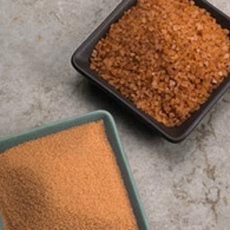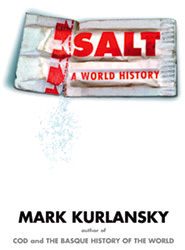

Alaea Sea Salt is a traditional Hawaiian table salt used to season and preserve. Alaea is a natural mineral volcanic baked red clay, added to enrich the salt with iron oxide. Photo courtesy of Saltworks.us, a wonderful resource for many types of gourmet salts. See many more sea salts in our Salt Glossary.
June 2006
Updated November 2008
|
 |
Product Reviews / Main Nibbles / Seasonings
A Brief History of Salt
Page 2: The Orgins Of Salt, Continued
This is Page 2 of a four-page article. Click on the black links below to visit other pages.
The history of sea salt continues in the Middle Ages:
-
Merchants in 12th century Timbuktu valued salt as highly as books and gold. In Venice, whose economic strength was not just as a seaport but as a major salt-producer, the immense salt evaporation pans were referred to colloquially as “the Seven Seas.” The phrase “sailing the Seven Seas” derived from the challenge of navigating one’s craft among the bars that enclosed these evaporation ponds.
-
Salt was traditionally expensive, and thus used to bestow social standing. In Medieval and Renaissance European kingdoms, salt cellars would be placed on the table within reach of those deemed worthy. At any noble table, to be seated “below the salt” was to be seen as unworthy of access to such luxury seasoning.
-
Throughout history, the necessity of salt has subjected it to governmental monopoly and special taxes. Salt taxes long supported British monarchs; thousands of Brits were imprisoned for smuggling salt. French kings developed a salt monopoly by selling exclusive rights to produce it to a favored few, who exploited that right to the point where the scarcity of salt was a major cause of the French Revolution.
-
Americans have been fortunate to have had a plentiful natural salt supply that has not been appropriated for the privileged or taxed. It is one of our least expensive necessities; although in times of shortage, like the Civil War, the Union army was quick to blow up Confederate saltworks to further starve the South, and profiteers (including the founders of the McIlhenny Company, makers of  Tabasco Tabasco, who owned brine wells in Louisiana) used the shortages to their advantage.
-
As you’ll read in the final section, salt in the 21st century means a steady supply of deliciously flavored sea salts from all over the world. The basic necessity has gone gourmet.
For more information, read the definitive book on the topic, Salt: A World History, by Mark Kurlansky (photo at right). You’ll find an exhaustive, yet wonderful, history of salt. Combining the historical with the contemporary, the practical with the whimsical, this is a delightful treatise on salt. Click on the link to get a copy.
Continue To Page 3: The Chemistry Of Salt
Go To The Article Index Above
Lifestyle Direct, Inc. All rights reserved. Images are the copyright of their respective owners.

|





